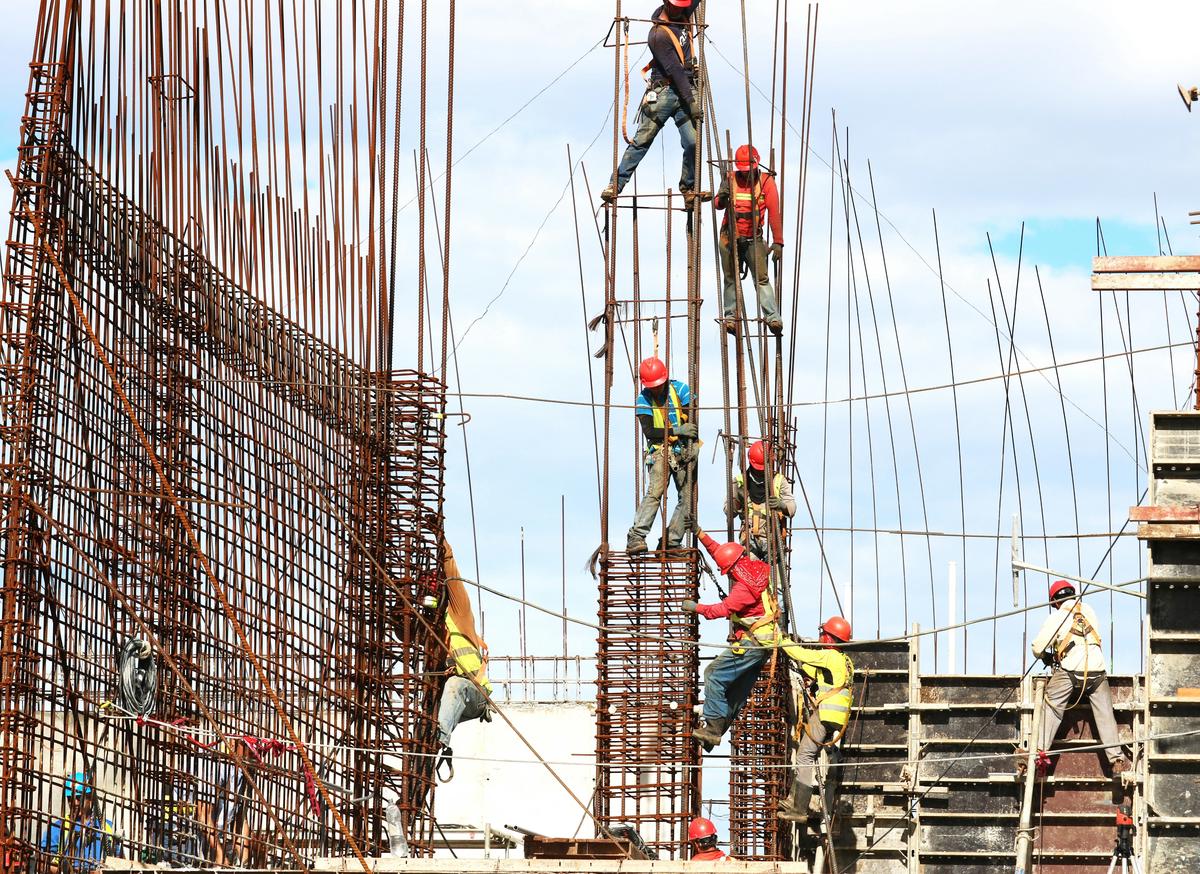Top Jobs in the USA for Immigrants
Tabla de contenidos
The economic and social fabric of the United States is, in many ways, woven together by the vibrant threads of migrant labor. From the sprawling farms that feed a nation to the rise of technology behemoths, the influence of international workers stretches far and wide. Through an exploration of the multifaceted roles that these workers adopt, this discussion aims to highlight not only the industries that thrive on the ingenuity and determination of migrants, but also the profound impact these individuals have on America’s economic vigor. As we delve into the legal framework and employment rights designed to protect the interests of migrants, a nuanced understanding of the United States labor market emerges, demonstrating the nation’s dependency on the eclectic tapestry of skill sets migrants provide.
The Economic Impact of Migrant Workers
The Indispensable Role of Migrant Workers in the U.S. Economy
Within the ambit of the United States economy, migrant workers emerge as a silent yet formidable force, powering key industries with the resilience and labor that form the sinews and backbone of the market. These workers, while often occupying roles that seem to eschew the limelight, are in fact integral cogs in the wheel of economic functionality.
From agricultural fields to bustling kitchens and construction sites, migrant laborers undertake tasks that are crucial yet frequently undervalued. Their contribution is not merely a matter of manpower; they inject vitality into sectors that struggle to attract domestic workers, thereby ensuring continuity and growth.
Agricultural Productivity and Food Supply
Agribusiness, the heart of America’s food production, is heavily reliant on migrant workers. They are the hands that plant, tend, and harvest the crops that feed the nation and are exported across the globe, cementing the U.S.’ position as a major player in the global food market. Without migrant labor, which accounts for a significant portion of agricultural workforce, the industry would face an untenable scarcity of workers, leading to a dramatic decline in productivity, an increase in food prices, and a plausible disruption of food supply chains.
Services and Hospitality: The Backbone of Experience
In the hospitality sector, migrant workers are omnipresent, though often unseen, contributing to the fabric of customer experience. They are housekeepers in hotels, waitstaff in restaurants, and caretakers in homes – roles that, while essential, are hard to fill domestically. Migrant contribution here is twofold: sustaining the operational aspects of the industry and enriching it with cultural diversity that enhances the customer experience and drives economic activity through tourism and service.
Construction and Urban Development
Urban skylines forever surge skyward on the backs of migrant construction workers. Their labor addresses a market demand that builds communities and infrastructures. With labor shortages prevalent in this sector, migrants provide the necessary workforce to keep projects on schedule and within budget, thereby driving development and economic growth.
Innovation through Diverse Perspectives
Beyond manual labor, migrant workers bring a wealth of diverse perspectives, playing pivotal roles in innovation. They fill essential positions in science, technology, engineering, and math (STEM) fields, contributing to advancements that reinforce the U.S.’s status as a global leader in technological innovation. Their varied cultural backgrounds and experiences knit a richer tapestry of creativity and problem-solving, fueling progress and competitiveness.
Economic Ripple Effects
The participation of migrant workers in the U.S. economy creates a multiplicative effect. Their labor leads to growth in ancillary industries, and through their consumption patterns, they contribute to the health of local economies. From paying taxes to supporting local businesses, their participation in the socioeconomic ecosystem has tendrils that extend deep into the fabric of community prosperity.
Fiscal Contributions and Social Security
Migrant workers also make substantial contributions to public coffers through taxes. Contrary to prevailing misconceptions, many migrant workers pay income, sales, and property taxes, thereby supporting public services and infrastructure. Notably, they also contribute to the Social Security and Medicare systems, bolstering these programs’ solvency, despite often not being beneficiaries of them themselves.
In sum, the American economy is buoyed by the essential work of migrants. Their labor fills gaps in the workforce, fuels vital sectors, spurs innovation, and supports economic sustenance. The economic tapestry of the United States is woven with threads of various colors and textures, a mosaic in which the role of migrant workers cannot be overstated. This collective endeavor, marked by diligence and drive, is witness to the interconnected nature of our shared progress. Through this understanding, one garners a nuanced appreciation of how migrant workers are not merely participants in the U.S. economy but are paramount to its very vigor and sustainability.

Legal Framework and Employment Rights for Migrants
Navigating the Legal Landscape of Migrant Employment in the USA
The United States stands as a beacon of opportunity for individuals across the globe, drawing a diverse workforce that bolsters various sectors of its economy. Migrant workers, whether transient or aiming for permanence, must navigate the complex legal terrain that governs their employment. This critical examination of the legal considerations for migrant employment underscores the fine balance between a nation’s workforce needs and its regulatory frameworks.
Visa Regulations and Employment Authorization
Central to the employment of migrant workers in the US is adherence to visa regulations. Various visa categories exist, each with its stipulations and constraints. Nonimmigrant work visas such as the H-1B, allotted for specialty occupations, and the H-2A and H-2B, designated for agricultural and non-agricultural labor respectively, are pivotal channels through which migrant exert their labor.
Compliance with visa requirements is non-negotiable; employers must ensure that workers possess the requisite authorization. The verification process, encapsulated in the Form I-9 completion, is a legal mandate employers must meticulously follow. This underscores the employer’s role in maintaining the integrity of the legal workforce.
Labor Rights and Protections
Amidst legal procedures, it is paramount that migrant workers’ rights and protections are upheld as stringently as they are for US citizens. The Department of Labor enforces laws that safeguard these rights, casting a protective net over issues of wage, working conditions, and workplace discrimination.
The Fair Labor Standards Act (FLSA), for instance, ensures minimum wage and overtime pay for workers irrespective of immigration status. Equally, the Migrant and Seasonal Agricultural Worker Protection Act (MSPA) specifically shields those in the agricultural sector, a realm heavily populated by migrants.
These statutory protections exhibit the underlying principle that legality of presence should not equate to a forfeiture of fundamental human work rights.
Immigration Reform and Control Act (IRCA)
The IRCA, enacted in 1986, plays a pivotal role in the employment of migrants. Primarily, it prohibits the knowing hire or continued employment of individuals who do not have proper authorization to work in the US. It nestles the responsibility squarely with the employer to authenticate the eligibility of their workforce.
The Act also imbued the landscape with a sanction regime for non-compliance, subjecting employers to fines and, in grievous cases, criminal penalties. This legislation underscores the need for a diligent approach to migrant employment, reflective of a nation delineating clear legal parameters to uphold its sovereignty while harnessing global human capital.
E-Verify System
An adjunct to the immigration compliance milieu is the E-Verify system. It provides employers with a mechanism to electronically confirm the employment eligibility of their workforce. While participation in E-Verify is voluntary for most employers, it becomes obligatory for certain federal contractors and in states with specific legal requirements regarding its use.
This system presents a dual-edged sword—enhancing the integrity of employment practices while thrusting upon employers an additional layer of regulatory obligation.
Challenges and Implications
Despite comprehensive legal frameworks, challenges persist. Legal complexity may ensnare unwitting employers and workers alike, leading to inadvertent non-compliance or exploitation. Furthermore, the capricious nature of immigration policies and enforcement can introduce uncertainty, impacting both the stability of the workforce and employer compliance strategies.
Moreover, the intersection of federal, state, and local laws can conjure a labyrinthine legal environment wherein employers must be both cognizant and adaptive. For migrants, navigating this terrain can be daunting, cultured by variations in language, legal literacy, and socio-economic backing.
Conclusion
For migrant employment to continue its crucial contribution to the US economy, a robust understanding of the intertwining legal considerations is essential. Only through a symbiotic relationship—where compliance coexists with humane employment practices—can the true potential of this dynamic workforce be realized.
The legal intricacies surrounding migrant employment demand an ever-vigilant approach. Employers, while capitalizing on a global talent pool, must operate within the legal peripheries, safeguarding rights as they fulfill economic imperatives. Migrant workers, in turn, must exercise a keen awareness of their entitlements, ensuring their labor is both valued and legal.
The preservation of these legal protocols and principles is fundamental, not merely for the orderly operation of the nation’s workforce but also as a testament to the essential humanity that underpins employment within the borders of the United States.

Top Industries and Positions for Migrant Employment
Navigating Opportunities: Key Sectors for Migrant Success in the USA
In the intricate tapestry of the US economic landscape, migrant labor is a thread that weaves through numerous industries, vitalizing and supporting the fabric of our collective productivity. While some sectors surge to the forefront, offering robust opportunities for migrants, others present a more complex interplay of demand and regulatory navigation.
Healthcare Horizon
The healthcare industry stands as a bastion of potential for migrants, buoyed by an aging population and an increasing need for both specialized and general care professionals. From physicians to home health aides, the sector’s workforce is an epitome of diversity, with migrants playing an indispensable role in delivering care across the country’s urban and rural expanses.
According to the Bureau of Labor Statistics (BLS), healthcare professions are projected to witness one of the fastest growth rates into the next decade. The intrinsic human need for medical services renders this field less susceptible to economic downturns, positioning it as a stronghold for migrants seeking stable employment opportunities.
Technology and Innovation
Technology and innovation sectors beckon with a promise of boundless potential for those wielding expertise in science, technology, engineering, and mathematics (STEM). The voracious appetite for innovation in Silicon Valley and beyond creates a fertile landscape for talented individuals hailing from distant shores. Their contributions not only spark technological advancements but also ignite the mechanisms of economic growth through job creation and spurring investments.
Hospitality and Tourism
Meanwhile, the hospitality and tourism domain persists as a magnetic field for migrant labor. With its spectrum of roles from culinary arts to hotel management, this vibrant sector thrives on human interaction and cultural exchange, making it uniquely open to the eclectic backgrounds migrants bring to the table.
Education and Teamwork
The realm of education also presents a tableau of opportunities for migrant professionals. The exchange of global perspectives benefits both the educators and the students, enriching the academic environment with a breadth of experiences. Furthermore, in areas where there is a shortage of qualified teachers, migrants can play a pivotal part in shaping the minds of future generations.
Legal Framework and Market Forces
It is essential to acknowledge, however, that success in these sectors is not entirely unencumbered. Navigating the USA’s complex legal framework surrounding work visas and employment laws requires a strategic understanding of both market forces and regulatory requirements.
Successful integration into the workforce hinges on meeting qualifications and overcoming credential recognition hurdles. English proficiency and cultural acclimatization emerge as notable factors that augur well for the upward mobility of migrant workers.
Collaboration and Advancement
Cementing the importance of collaboration between industries and policymakers, there lies a shared responsibility to foster an ecosystem conducive to the prosperity of migrants. This symbiosis facilitates not only individual advancement but also contributes to a collective economic dynamism.
Conclusion
In closing, as the United States continues to evolve, migrant workers will indubitably remain integral contributors across multiple sectors. Accurate identification of flourishing industries paired with pragmatic and legal discernment sets the stage for migrant success. Ensuring access and harnessing the full potential of this diverse workforce is not just an ethical imperative; it is a strategic investment in the nation’s enduring prosperity.

Future Prospects and Challenges in Migrant Employment
The Horizon of Migrant Employment in the USA: Prognostications and Projections
As the American tapestry is being woven through the threads of diverse populations, migrant workers remain one of the most vital strands in the economic, cultural, and social fabric of the nation. The future of migrant employment in the United States is enmeshed in the ongoing interplay between policy reform, economic demand, and the transformative power of global migration patterns. This confluence of factors signals a forthcoming chapter of opportunities and challenges, which necessitates a careful examination from the vantage point of today’s knowledge.
Migrant Workforce: Future Prospects and Pathways
Migrants, who steer through the myriad of industries with fluid adaptability, look to the horizon with cautious optimism. Future employment prospects for migrants will likely continue to evolve as labor markets respond to the twin engines of technological innovation and geopolitical shifts. Now, let us uncover what this evolution could entail for these tireless contributors to the nation’s prosperity.
Demographic Shifts and Labor Demands
The US economy’s gears churn in synchronicity with demographic changes, and the coming years promise to be indicative of such dynamics. Aging populations in various sectors could create expansive voids, with migrant labor poised to fill the gap. The care industry, in its breadth, including eldercare, healthcare, and childcare, is likely to burgeon, thus demanding a steady influx of compassionate and skilled migrant workers.
Policy Landscapes: Reform and Implications
The silhouette of migrant employment in the US also draws its shape from the legislative easel. With whispers of labor shortages echoing in halls of power, prudent immigration policies could become linchpins in the strategy to replenish and fortify the workforce. The possibility of policy reforms, either amplifying or attenuating accessibility to work visas, will indubitably sculpt the face of migrant labor for years to come.
Integration Through Vocational Training and Education
Equally pivotal is the trajectory of migrants as they amalgamate into the workforce through educational and training pathways. Vocational programs tailored to align with emergent industry requirements echo the synergy between economic preparation and employment success. In unison with scholarships and accessible higher education for migrants, these cadres infuse the employment landscape with an elevating level of expertise and readiness.
Sustainable Employment: The Ecological Chapter
Sustainability concerns and ecological imperatives are coaxing new sectors to the fore, where migrant labor holds vast potential. Renewable energy industries, environmental engineering, and green technology are flourishing fields that may magnetize migrant workers, offering a novel intersection of employment and planetary stewardship.
Informatics and Automation: A Nexus of Change
As the digital metamorphosis of the workplace accelerates, migrants with digital acumen could become pivotal assets. Automatable vocations will undergo a shift, prompting migrants to pivot into roles that effectively amalgamate human ingenuity with automated efficiency. Yet, amidst this digital proliferation, the essence of migrant employment must hinge on upskill training, lest job displacement becomes an unshackled specter.
The Versatility of Entrepreneurship
Entrepreneurship, in its bold vigor, remains a beacon for migrant workers. The fertile soil of the American enterprise ecosystem can propagate the growth of migrant-led businesses, fostering innovation and stimulating local and national economies. By encouraging this entrepreneurial spirit, migrant workers can metamorphose from employees to employers, demonstrating the cyclical vitality they invite into the economy.
Community Ties and Societal Weave
Beyond the economic sphere, the social and cultural influence of migrants injects vibrancy into local communities. An enriched diversity of thought, tradition, and innovation benefits not just migrant enclaves but the society at large. This cultural capital sewn by migrant workers embellishes the societal tapestry, making it robust and radiant with multicultural threads.
Conclusion
In extrapolating the prospective blueprint of migrant employment in the United States, one discerns a multidimensional vista burgeoning with promise and laden with complexities. As workers migrate across oceans and borders, so too does the anticipation of a future where their labor, ingenuity, and cultural contributions continue to be revered as cornerstones upon which America’s economic magnanimity rests.
This foresight, cast amidst the specter of ever-shifting geopolitical and economic climates, underscores the essence of adaptability and resilience threaded within the migrant ethos. Their journey, painted upon the vast canvas of American industry and prosperity, shall remain a testament to the enduring symbiosis between the nation and those who journey to it in pursuit of opportunity and collective advancement.

As the sun sets on this exploration of migrant employment in the United States, it becomes evident that the tapestry of the nation’s workforce is ever-evolving. The adaptability and resilience displayed by migrant workers remain crucial to the survival and success of numerous industries, even as they navigate the complexities of the American job market. It is the blend of challenges and opportunities that will continue to shape the experiences of these essential contributors to the US economy. Acknowledging their indispensable role is the key to fostering an environment that harnesses their potential and ensures the mutual prosperity of both migrants and the nation at large.




